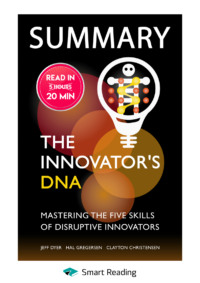Read the book: «Summary: The Innovator’s DNA. Mastering the Five Skills of Disruptive Innovators. Jeff Dyer, Hal Gregersen, Clayton Christensen»
Автор:
Jeff Dyer, Hal Gregersen, Clayton Christensen
Оригинальное название:
The Innovator’s DNA. Mastering the Five Skills of Disruptive Innovators
www.smartreading.ru
Anyone Can Be an Innovator
In recent years, many books have been published on creativity and innovation in business. But there is a problem: the leaders of large organizations have no idea that it is possible to think differently. This is not taught in business schools. MBA programs explain how to become providers of goods and services, but not researchers.
The Innovator’s DNA book is the result of an eight-year study of disruptive innovators and the innovative companies they established. The authors interviewed hundreds of creators of successful projects and products, leaders, and founders of revolutionary companies. Their answers helped us understand where breakthrough ideas come from.
It turns out that the behavior of innovative entrepreneurs and leaders is largely similar. Firstly, their thinking skillfully connects various things, thoughts, and phenomena, which leads to the creation of unique ideas. In addition, all innovators excelled at questioning, observing, networking, and experimenting.
People think that creativity is a cognitive skill, however the ability to create innovative ideas is not only derived from your brain, but also from your behaviors. Thus, by changing your behavior, you can improve your creativity. Innovative companies are always led by innovative leaders, so if you want to create something truly new, you first need to be creative.
What makes innovators different?
Many people are convinced that people are endowed with creativity by nature: it’s just that some people’s right hemisphere is better developed and, as a result, so it their intuition. However, research results disprove this misconception.
The most comprehensive study of the origin of creativity was done by a group of researchers, Merton Reznikoff, George Domino, Carolyn Bridges, and Merton Honeyman. They studied the creative abilities of 117 pairs of twins aged 15 to 22 and found that only about 30 % of the creative activity of identical twins had a genetic origin. In contrast, roughly 80 to 85 percent of the general intelligence (IQ) tests could be attributed to genetics.
So general intelligence is basically a genetic endowment, but creativity is not. About two-thirds of innovative skills are acquired during the learning process. Our environment also affects our ability to develop creativity. Societies that promote community versus individualism and hierarchy over merit – such as Japan, China, Korea, and many Arab nations – are less likely to innovate or produce a Nobel Prize winner.
The authors of this book studied about 500 innovators out of 5,000 heads of companies and were able to identify five discovery (research) skills that distinguish innovators from ordinary leaders. First and foremost, innovators count on a cognitive skill that we call "associational thinking" or simply "associating". Other discovery skills, questioning, observing, networking, and experimenting, are all behavioral in nature. These discovery skills, combined with innovative courage, form the innovator’s DNA model, or the source code for generating innovative business ideas.
The free sample has ended.








